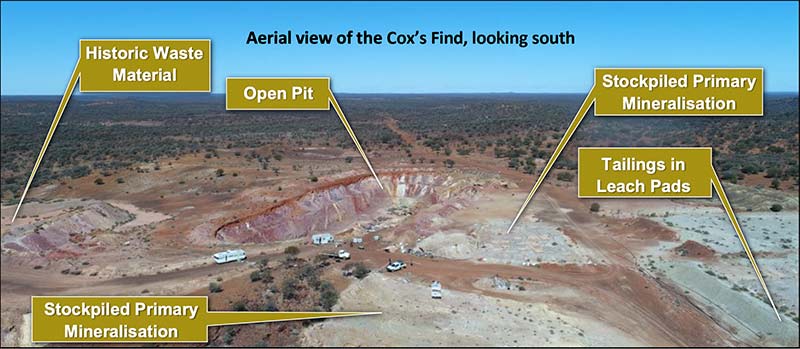Great Southern eyes early cashflow from stockpiled ore at high grade Cox’s Find
Mining
Mining
Special Report: Great Southern aims to transform the historic, high-grade Cox’s Find gold mine into a major new gold operation. But first, the explorer is looking at strong early cashflow from abundant stockpiles, leach pads, and historic material on surface.
Great Southern Mining (ASX:GSN) has hit the ground running since it finalised the acquisition of Cox’s Find, on WA’s gold-rich Duketon Greenstone Belt, in late August.
It’s a very exciting project. Cox‘s Find was Western Mining Corporation’s (WMC) first foray into Australian gold production, producing 77,000 ounces at more than 21 grams per tonne (g/t) between 1935 and 1942.
>> Learn more about Great Southern Mining
In today’s terms — when +5g/t is generally considered high grade — that would make Cox’s Find one of the highest-grade gold mines in Australia.
Since then, exploration has been sporadic at best. Over the past 30 years, the mine has been essentially dormant under private ownership.
Covered by three mining leases, the current site includes a shallow 15m open pit, underground mining stopes, untreated stockpiles of ore on the surface, and remnant tailings from the underground operation:

While waiting on approvals for a planned drilling program, targeting both shallow and deeper gold mineralisation at Cox’s Find, the explorer is undertaking the work required to deliver a JORC 2012 compliant resource on this easy-to process surface material and then examine monetisation options.
Using a third-party mill, those ore stockpiles represent significant near-term cash for Great Southern at today’s +$2200/oz gold price.
Remember, the explorer is paying ~$1m for this project – and there’s a lot of gold ounces just sitting there.
Via a recent drone survey, Great Southern has already figured out that stockpiled primary mineralisation has a weighted average grade of 1.7g/t gold, while the 15, 50m-by-50m heap leach pads have an average grade of 1.3g/t.
That may sound low grade, but most gold mill head grades are getting lower and lower.
And then there’s the historic “waste dump” material at Cox’s Find, mostly from the 1940s mining operation.

‘Waste’ is a misnomer, because WMC had an ore cut-off grade of about 12g/t. That means anything under 12g/t was discarded.
When the drill rig gets to site, Great Southern plans to undertake an initial reverse circulation drilling program on this historical waste material to determine grade and tonnages.
READ: Cox’s Find produced 77,000oz gold at 21g/t … but that’s just the tip of the iceberg
All this material – stockpiles, heap leach pads and the waste dump — represents strong early cashflow for Great Southern.
It is weathered, easy to process ore with no metallurgical issues that can just be sold via an ore sale agreement and trucked away to an existing mill.
Further out, Great Southern chairman John Terpu says that Cox’s Find could become a substantial gold mine on the Duketon Greenstone Belt.
There is real potential that each reef (circled in red, below) hosts in the order of 150,000oz of high-grade gold, Terpu says.

“One only has to look at the depths of extraction and of modern-day mining (and subsequent resource cut-offs) to know that this wouldn’t be the first historic gold mine to be resurrected on significant ounces discovered at depth,” Terpu says.
“WMC mined the underground all by hand, and with a historic cut-off grade of 12g/t – how much gold is left down there?”